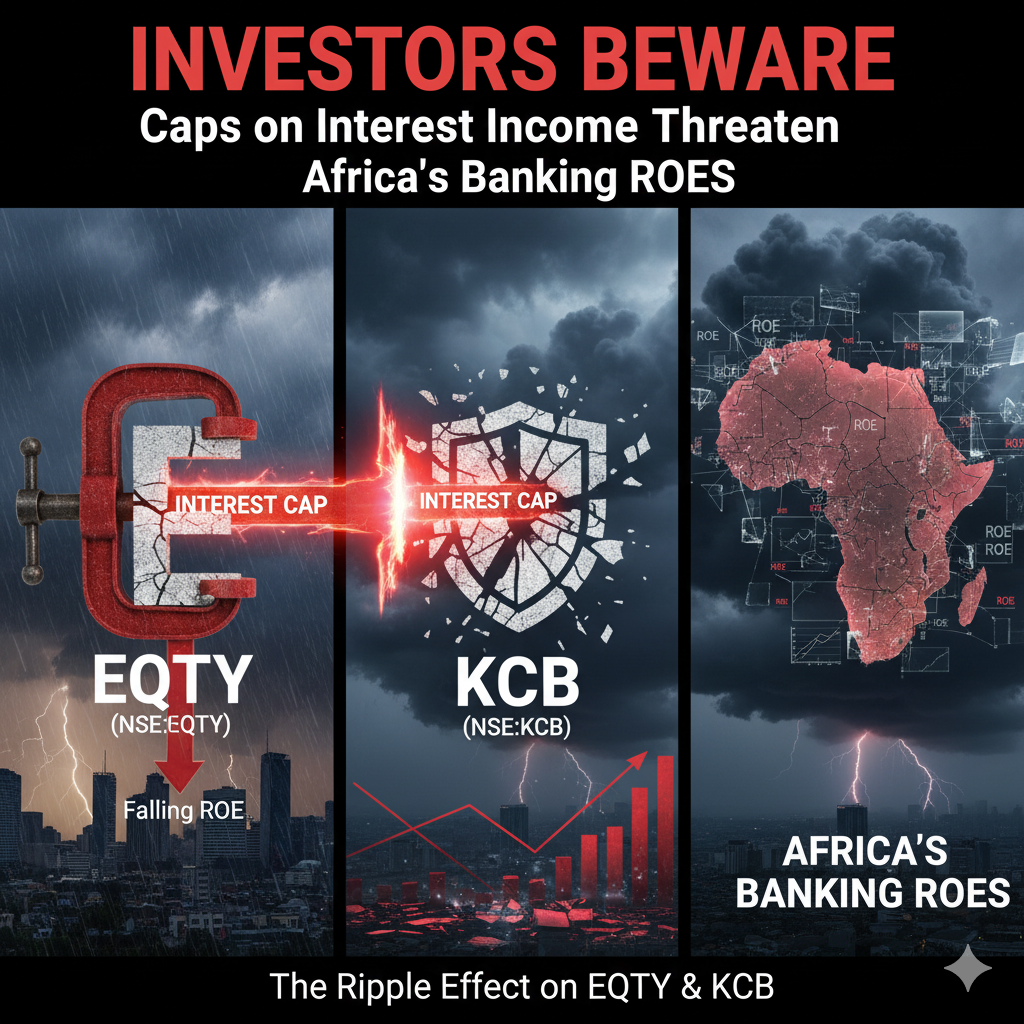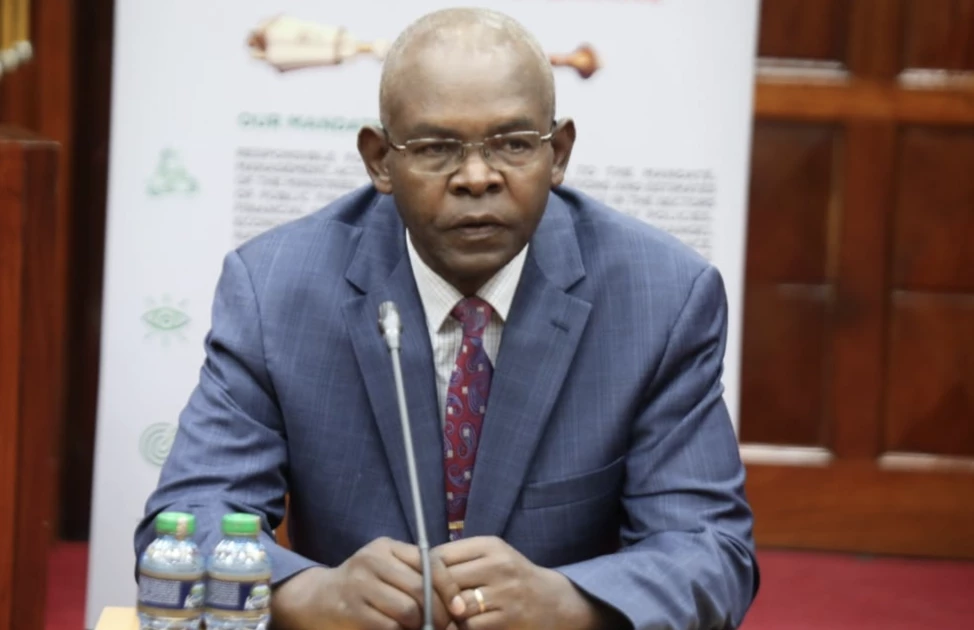Investors Beware: Caps on Interest Income Threaten EQTY (NSE:EQTY), KCB (NSE:KCB) and Africa’s Banking ROEs
Kenya MPs eye stricter in duplum rule as NPLs hover at 15%. Equity (NSE:EQTY, mcap US$2.2bn) and KCB (NSE:KCB, mcap US$1.8bn) risk margin compression with net interest income >65% of revenue. Banks may retreat to corporates, reshaping Africa’s credit landscape.

Kenya’s Parliament is again considering reforms that could redefine banking economics. Lawmakers are debating amendments to the Consumer Protection Act that would reinforce the in duplum rule, which bars lenders from charging interest and penalties exceeding the original principal. If enacted, the rule would fundamentally change how banks price risk, manage credit portfolios, and generate returns. For investors, the consequences will not remain confined to Nairobi; they carry implications for banking across Africa.
The in duplum rule’s logic is simple: a borrower should never pay more in interest than the amount they borrowed. For consumers, this is protection against predatory lending and compounding debt spirals. But for banks, the measure reduces flexibility in pricing credit risk. In economies where collateral is weak, defaults are high, and enforcement slow, the ability to recover costs through interest and penalty accrual is one of the few buffers lenders have. Removing or capping that cushion compresses net interest margins and raises the risk premium banks must absorb.
Kenya’s past experiment with interest rate caps between 2016 and 2019 is instructive. Lending growth slowed sharply, particularly to SMEs and unsecured borrowers, as banks redirected credit toward low-risk corporates and government securities. Private sector credit growth fell from 25 % in 2015 to under 4 % by 2017. During that period, bank valuations on the Nairobi Securities Exchange (NSE) compressed as investors repriced weaker earnings visibility. Equity Group Holdings (NSE: EQTY), KCB Group (NSE: KCB), and Co-operative Bank of Kenya (NSE: COOP) all traded at lower price-to-book multiples, reflecting reduced return on equity.
Today, the stakes are even higher. Equity Bank, Kenya’s largest lender, reported a net interest margin of 8.1 % in FY2024, with interest income contributing over 70 % of total revenue. KCB Group’s loan book stood at KSh 1.1 trillion in H1 2025, with net interest income accounting for 66 % of operating income. A strict in duplum regime would cut into these streams, forcing banks to rely more heavily on non-interest income such as fees and commissions, which historically make up less than 30 % of revenue for Kenyan banks. Co-operative Bank, for instance, posted non-interest income of KSh 22.5 billion in 2024, less than a third of its operating income. These figures highlight how exposed the sector remains to changes in interest income regulation.
For investors, the first risk is margin compression. If banks cannot recover interest beyond principal on delinquent loans, their profitability models weaken. The average non-performing loan (NPL) ratio in Kenya stands at around 15 %, one of the highest in Sub-Saharan Africa, compared to 8 % in Nigeria and 5 % in South Africa. With such a large share of loans already stressed, reducing recovery options will directly erode banks’ bottom line.
The second risk is credit allocation distortion. As seen previously, banks may pivot away from unsecured consumer and SME loans — the very segments policymakers wish to protect. Lending will shift to corporates, multinationals, and government securities, which are safer but generate lower yields. This undermines financial inclusion and constrains private-sector growth, with long-term implications for GDP expansion.
The third risk is sectoral restructuring. Larger, better-capitalized banks like Equity Group (market cap ~US$2.2 billion) and KCB Group (market cap ~US$1.8 billion) may absorb the policy shock by leveraging regional diversification and fee income. Smaller banks, however, lack the buffers to withstand margin cuts and could face consolidation or exit. Investors should anticipate accelerated concentration of market share, with top-tier banks entrenching dominance while mid- and lower-tier lenders become acquisition targets or fade.
Beyond Kenya, the policy debate resonates across Africa. Nigeria has periodically floated tighter caps on lending rates, while Uganda and Zambia face similar populist pressures to rein in high borrowing costs. South Africa enforces strict consumer credit laws that cap charges and interest. If Kenya proceeds, it could embolden lawmakers elsewhere to impose similar restrictions, creating a patchwork of credit regulation that complicates strategy for pan-African lenders like Ecobank Transnational (NGX: ETI) and Standard Bank Group (JSE: SBK).
For global investors, the implications are twofold. On one side, consumer protection measures can stabilize households and limit systemic risk from predatory lending. On the other, they diminish bank profitability, weaken credit intermediation, and risk driving borrowers toward unregulated informal lenders or fintech platforms outside supervisory reach. With banking stocks in frontier markets already trading at discounts — Kenyan banks average price-to-book of 0.8x compared to 1.2x for Nigerian peers and 1.5x for South African lenders — additional regulatory overhang could deepen undervaluation.
Kenya’s MPs may see the reform as a moral corrective, but for investors it is a financial stress test. The law would cap banks’ upside on risky lending while leaving downside risks intact. Earnings volatility, provisioning needs, and legal disputes could all rise. Dividend payouts may be curtailed, with return on equity trending downward. The sector’s long-term viability will depend on banks’ ability to diversify revenue, cut costs, and adapt to a lower-margin model.
Ultimately, the renewed push for interest caps in Kenya highlights Africa’s dual narrative: a continent of immense demographic opportunity but also persistent regulatory and political risk. Investors cannot ignore either side. As the debate unfolds, the question is not just whether Kenyan borrowers will be protected from paying more than they owe, but whether the banking sector — and by extension the continent’s financial system — can remain profitable enough to keep lending.





